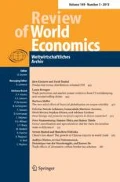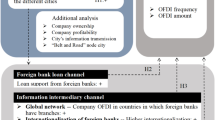Abstract
This paper presents differences in firm-level total factor productivity (TFP) across 22 manufacturing and 17 service industries in Germany over the period 1995–2004. It is an attempt to study whether and to what extent foreign multinational enterprises (MNEs) are more productive relative to German firms. As well as distinguishing between foreign and domestic firms, we also distinguish between German MNEs and domestic firms that do not have any foreign presence. Controlling for endogeneity through semi-parametric techniques, our findings indicate considerable heterogeneity in firm performance across types of firms. The foreign/domestic distinction is not as clear cut as has been suggested elsewhere; multinationality is important in explaining productivity differences rather than foreignness.
Similar content being viewed by others
References
Ackerberg, D., K. Caves, and G. Frazer (2005). Structural Identification of Production Functions. Working Paper, available at http://www.colorado.edu/Economics/seminars/ackerberg.pdf
Alvarez, R., and R. Lopez (2005). Exporting and Performance: Evidence from Chilean Plants. Canadian Journal of Economics 38 (4): 1384–1400.
Arnold, J. M., and K. Hussinger (2006). Exports versus FDI in German Manufacturing: Firm Performance and Participation in International Markets. Discussion Paper 04/06. Deutsche Bundesbank, Frankfurt am Main.
Bellak, C., and M. Pfaffermayr (2002). Why Foreign-Owned Firms Are Different: A Conceptual Framework and Empirical Evidence for Austria. In R. Jungnickel (ed.), Foreign-Owned Firms: Are They Different? Basingstoke: Palgrave.
Bellmann, L., and R Jungnickel (2002). Why Do Foreign-Owned Firms in Germany Achieve Above-Average Productivity? In R. Jungnickel (ed.), Foreign-Owned Firms: Are They Different? Basingstoke: Palgrave.
Blalock, G., and P. Gertler (2004). Learning from Exporting: Revisited in a Less Developed Setting. Journal of Development Economics 75 (2): 397–416.
Blomström, M., S. Globerman, and A. Kokko (2001). The Determinants of Host Country Spillovers from Foreign Direct Investment. In N. Pain (ed.), Inward Investment, Technological Change and Growth. Basingstoke: Palgrave.
Braconier, H., and K. Ekholm (2002). Locating Foreign Affiliates in Germany: The Case of Swedish Multinational Enterprises. In R. Jungnickel (ed.), Foreign-Owned Firms: Are They Different? Basingstoke: Palgrave.
Budd, J. W., J. Konings, and M. J. Slaughter (2005). Wages and International Rent Sharing in Multinational Firms. Review of Economics and Statistics 87 (1): 73–84.
Castellani, C., and A. Zanfei (2006). Attracting Foreign Investments or Promoting Domestic Multinationals? Evidence from Productivity Spillovers in Italy. Paper presented at EARIE, Amsterdam.
Conyon, M., S. Girma, S. Thompson, and P. Wright (2004). Do Wages Rise or Fall Following Merger? Oxford Bulletin of Economics and Statistics 66 (5): 847–862.
Criscuolo, C., and R. Martin (2005). Multinationals, Foreign Ownership and Productivity in UK Businesses. Working Paper 024. Advanced Institute of Management Research, London.
Davies, S. W., and B. R. Lyons (1991). Characterising Relative Performance: The Productivity Advantage of Foreign Owned Firms in the UK. Oxford Economic Papers 43 (4): 584–595.
Doms, M. E., and B. J. Jensen (1998). Comparing Wages, Skills, and Productivity between Domestically and Foreign-Owned Manufacturing Establishments in the United States. In R. E. Baldwin, R. E. Lipsey, and J. D. Richardson (eds.), Geography and Ownership as Bases for Economic Accounting. Studies in Income and Wealth 59. Chicago: University of Chicago Press.
Department of Trade and Industry (2006). International Trade and Investment – The Economic Rationale for Government Support. Economics Paper 18, available at http://www.dti.gov.uk/files/file32297.pdf
Dunning, J. H. (1988). The Eclectic Paradigm of International Production: A Restatement and Some Possible Extensions. Journal of International Business Studies 19 (1): 1–31.
Federal Ministry of Economics and Technology (2007). Press Release Given by Federal Minister of Economics and Technology, Mr Michael Glos and The Federal Government Commissioner, Mr Wolfgang Tiefensee. Available at http://www.bmvbs.de/en/Federal-Government-Commissione/Economy-and-investments-,2575.985440/Tiefensee-and-Glos-Activities-.htm
Globerman, S., J. C. Ries, and I. Vertinsky (1994). The Economic Performance of Foreign Affiliates in Canada. Canadian Journal of Economics 27 (1): 143–156.
Görg, H., and D. Greenaway (2004). Much Ado about Nothing? Do Domestic Firms Really Benefit from Foreign Direct Investment? World Bank Research Observer 19 (2): 171–197.
Griffith, R. (1999). Using the ARD establishment level data to look at foreign ownership and productivity in the United Kingdom. Economic Journal 109 (June): 416–442.
Griffith, R., and H. Simpson (2004). Characteristics of Foreign-Owned Firms in British Manufacturing. In D. Card, R. Blundell, and R. Freeman (eds.), Seeking a Premier Economy: The Economic Effects of British Economic Reforms, 1980–2000. Chicago: University of Chicago Press.
Griffith, R., R. Redding, and H. Simpson (2004). Foreign Ownership and Productivity: New Evidence from the Service Sector and the R&D Lab. Oxford Review of Economic Policy 20 (3): 440–456.
Griffith, R., R. Harrison, and J. Van Reenen (2006). How Special Is the Special Relationship? Using the Impact of US R&D Spillovers on UK Firms as a Test of Technology Sourcing. American Economic Review 96 (5): 1859–1875.
Halvorsen, R., and R. Palmquist (1980). The Interpretation of Dummy Variables in Semilogarithmic Equations. American Economic Review 70 (3): 474–475.
Helpman, E., M. J. Melitz, and S. R. Yeaple (2004). Export versus FDI with Heterogeneous Firms. American Economic Review 94 (1): 300–316.
Howenstine, N. G., and W. J. Zeile (1992). Foreign Direct Investment in the United States: Establishment Data for 1987. Survey of Current Business 72 (10): 44–78.
IMF (International Monetary Fund) (1993). Balance of Payments Manual. Fifth Edition. Washington D.C.: IMF.
Konings, J., and A. Murphy (2006). Do Multinational Enterprises Relocate Employment to Low-Wage Regions? Evidence from European Multinationals. Review of World Economics/Weltwirtschaftliches Archiv 142 (1): 1–20.
Laafia, I. (2002). Employment in High Tech and Knowledge Intensive Sectors in the EU Continues to Grow in 2001. Eurostat, Statistics in Focus: Science and Technology 9 (4): 1–8.
Levinsohn, J., and A. Petrin (2003). Estimating Production Functions Using Inputs to Control for Unobservables. Review of Economic Studies 70 (2): 317–341.
OECD (Organisation for Economic Cooperation) (1996). Benchmark Definition of Foreign Direct Investment. Third Edition. Paris: OECD.
Olley, S., and A. Pakes (1996). The Dynamics of Productivity in the Telecommunications Equipment Industry. Econometrica 64 (6): 1263–1298.
Oulton, N. (1998a). Investment, Capital and Foreign Ownership in UK Manufacturing. NIESR Discussion Paper 141. National Institute of Economic and Social Research, London.
Oulton, N. (1998b). Labour Productivity and Foreign Ownership. NIESR Discussion Paper 143. National Institute of Economic and Social Research, London.
Peri, G., and D. Urban (2006). Catching-up to Foreign Technology? Evidence on the Veblen-Gerschenkron Effect of Foreign Investments. Regional Science and Urban Economics 36 (1): 72–98.
Sinn, H. W. (2000). Germany’s Economic Unification: An Assessment after Ten Years. NBER Working Paper 7586. National Bureau of Economic Research, Cambridge, Mass.
Smarzynska Javorcik, B. (2004). Does Foreign Direct Investment Increase the Productivity of Domestic Firms? In Search of Spillovers through Backward Linkages. American Economic Review 94 (3): 605–627.
Wagner, J. (2006). Exports, Foreign Direct Investment, and Productivity: Evidence from German Firm-Level Data. Applied Economics Letters 13 (6): 347–349.
Wooldridge, J. (2005). On Estimating Firm-Level Production Functions Using Proxy Variables to Control for Unobservables. Working Paper available at http://www.msu.edu/∼ec/faculty/wooldridge/current%20research/panel8r2.pdf
UNCTAD (United Nations Conference on Trade and Development) (2005). World Investment Report 2005. New York and Geneva: United Nations.
Author information
Authors and Affiliations
Corresponding author
Additional information
JEL no.
D24, F21, F23
About this article
Cite this article
Temouri, Y., Driffield, N. & Añón Higón, D. Analysis of Productivity Differences among Foreign and Domestic Firms: Evidence from Germany. Rev. World Econ. 144, 32–54 (2008). https://doi.org/10.1007/s10290-008-0136-1
Issue Date:
DOI: https://doi.org/10.1007/s10290-008-0136-1




